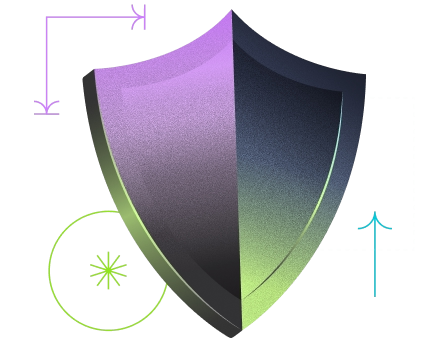As businesses navigate an ever more digitized environment, the question "what is cyber security" has become increasingly important for businesses and individuals alike. As threats evolve and digital transformation accelerates, understanding how to protect sensitive information and systems is no longer optional—it's essential.
At Yousign, security is at the core of everything we do. We understand that effective digital tools must be built on a foundation of robust protection. In this comprehensive guide, we'll explore the fundamentals of cyber security, common threats, best practices, and how you can better safeguard your digital assets.
What is Cyber Security: Core Concepts and Definitions
Cyber security refers to the practice of protecting systems, networks, programs, devices, and data from digital attacks, damage, unauthorized access, or exploitation. It encompasses a wide range of technologies, processes, and practices designed to defend against threats from both internal and external sources.
The primary goals of cyber security include:
- Confidentiality: Ensuring that sensitive information is accessible only to authorised individuals
- Integrity: Maintaining the accuracy and reliability of data and systems
- Availability: Guaranteeing that systems and data remain operational and accessible when needed
NB:
Cyber security is not just about implementing technical solutions—it's a continuous process that involves people, procedures, and technology working together to create comprehensive protection.
Types of Cyber Security: A Multi-Layered Approach
Effective protection requires addressing security across multiple domains:
Network Security
Network security focuses on protecting the integrity, confidentiality, and accessibility of computer networks and data. This includes implementing firewalls, intrusion detection systems, and network monitoring tools to identify and mitigate potential threats.
Modern network security often includes:
- Next-generation firewalls (NGFWs)
- Virtual Private Networks (VPNs)
- Network segmentation
- Software-defined perimeters
Application Security
Application security involves implementing measures within applications to prevent threats such as code injection, data breaches, and other vulnerabilities. This includes secure development practices, regular testing, and implementing security features within applications themselves. For businesses managing multiple applications, implementing effective contract management systems with built-in security features can help protect sensitive documentation.
Essential application security practices include:
- Secure code reviews
- Vulnerability scanning
- Penetration testing
- Runtime application self-protection (RASP)
Information Security
Information security (InfoSec) focuses specifically on protecting data, regardless of where it resides. This includes data encryption, access controls, and policies governing how information should be handled, stored, and transmitted.
Key components include:
- Data classification
- Encryption (at rest and in transit)
- Data loss prevention (DLP) systems
- Security information event management (SIEM) systems
Cloud Security
As more businesses migrate to cloud environments, cloud security has become a critical aspect of cyber security. This involves securing cloud infrastructure, platforms, and applications by implementing appropriate controls and monitoring systems.
Cloud security considerations include:
- Shared responsibility models
- Cloud access security brokers (CASBs)
- Cloud workload protection platforms
- Cloud security posture management
Identity and Access Management
Identity access management (IAM) encompasses the processes and technologies that manage digital identities and user access to systems, applications, and data. This includes authentication, authorization, and auditing of user activities.
Modern IAM implementations often feature:
- Single sign-on (SSO) capabilities
- Role-based access control
- Privileged access management
- Multi-factor authentication
Endpoint Security
Endpoint security protects devices like computers, smartphones, and tablets that connect to networks. This includes antivirus software, endpoint detection and response (EDR) tools, and device management solutions.
Essential endpoint security measures include:
- Advanced endpoint protection platforms
- Device encryption
- Mobile device management
- Endpoint detection and response (EDR)
Operational Security
Operational security involves the processes and decisions for handling and protecting data assets. This includes permissions management, asset classification, and determining how data is stored, used, and protected.
Good to know:
While each type of security focuses on specific aspects of protection, effective cyber security strategy requires an integrated approach that addresses all these domains in a coordinated manner.
Common Cyber Security Threats and Vulnerabilities
Understanding the threat landscape is crucial for developing effective security measures. Here are some of the most prevalent threats organisations face today:
Malware
Malware (malicious software) includes viruses, trojans, spyware, and ransomware designed to damage systems or steal information. Modern malware is increasingly sophisticated, often using evasion techniques to avoid detection.
Ransomware has become a significant threat, as demonstrated by the Colonial Pipeline attack in 2021, which disrupted fuel supplies across the eastern United States after attackers gained access through a single compromised password. Remember to implement multi-factor authentication for all remote access and maintain isolated, offline backups for critical systems.
Phishing and Social Engineering
Phishing attacks use deceptive communications, typically emails, to trick users into revealing sensitive information or downloading malware. These attacks often exploit human psychology rather than technical vulnerabilities.
Social engineering extends beyond phishing to include various manipulation techniques that exploit human trust to gain access to systems or information.
A typical business email compromise (BEC) attack involves an employee receiving an urgent email that appears to be from their CEO requesting an immediate wire transfer. The email address might look legitimate at first glance (ceo@company-name.com vs. the real ceo@companyname.com).
Man-in-the-Middle Attacks
In man-in-the-middle (MitM) attacks, attackers intercept communications between two parties, potentially eavesdropping or altering the data being exchanged.
These attacks can occur in everyday scenarios, such as when attackers set up rogue Wi-Fi hotspots in public places like cafés or near financial institutions. In one case, criminals intercepted banking sessions and modified transaction details in real-time while showing the intended details on the user's screen. Using banking apps instead of websites and verifying transactions through a second channel can provide protection.
Denial-of-Service (DDoS) Attacks
DDoS attacks overwhelm systems, servers, or networks with traffic to disrupt services. The business impact of these attacks was evident when the Mirai botnet targeted DNS provider Dyn in 2016, rendering major websites like Twitter and Netflix inaccessible by using over 100,000 compromised IoT devices with default passwords. Organizations should ensure all connected devices have strong, unique passwords and consider DNS redundancy to minimize points of failure.
Advanced Persistent Threats (APTs)
APTs are prolonged, targeted attacks where attackers establish a long-term presence within a network to steal data or monitor activities. These sophisticated attacks often target specific organisations or sectors and may be state-sponsored.
Supply Chain Attacks
Supply chain attacks target less-secure elements in the supply chain to gain access to more secure targets. The 2020 SolarWinds attack is a notable example, where malicious code was inserted into legitimate software updates, which were then distributed to approximately 18,000 customers, including government agencies and Fortune 500 companies.
Insider Threats
Not all threats come from external sources. Insider threats involve current or former employees, contractors, or business associates who misuse their access to critical assets. These threats can be malicious or unintentional.
A telling example occurred when a healthcare worker accessed the medical records of more than 3,000 patients without legitimate reasons over two years, viewing personal information of colleagues and acquaintances. The breach was only discovered during a routine audit. Implementing the principle of least privilege and using automated tools to flag unusual access patterns can help detect such threats earlier.
Important:
The cyber threat landscape is constantly evolving, with new attack vectors emerging regularly. Staying informed about current threats is a crucial component of an effective security posture.
Cyber Security Best Practices for Organisations
Implementing robust security requires a comprehensive approach that addresses people, processes, and technology:
Develop a Comprehensive Security Strategy
A well-defined cyber security strategy should align with business objectives while addressing the specific risks faced by your organisation. This includes:
- Risk assessment and management
- Security policies and standards
- Governance framework
- Compliance requirements
Implement Strong Access Controls
Control who can access your systems and data by:
- Implementing the principle of least privilege
- Using multi-factor authentication
- Adopting role-based access control
- Regularly reviewing and updating access rights
Keep Systems Updated
Vulnerabilities in outdated software are a common entry point for attackers. Ensure:
- Regular patching and updates
- End-of-life system replacement
- Automated vulnerability management
- Change management processes
Deploy Layered Security Controls
No single security measure is foolproof. Implement multiple layers of protection, including:
- Next-generation firewalls
- Intrusion detection/prevention systems
- Email filtering
- Web security gateways
- Data loss prevention tools
Establish Incident Response Security Procedures
When incidents occur, having established procedures helps minimise damage:
- Create an incident response plan
- Assemble a response team
- Define escalation procedures
- Regularly test and update your plan
- Implement lessons learned from incidents
This approach is similar to how businesses should prepare for other operational challenges, such as managing remote teams effectively during disruptions.
Conduct Regular Security Awareness Training
Human error remains one of the biggest security vulnerabilities. Address this by:
- Providing regular security training to all employees
- Conducting simulated phishing exercises
- Creating clear security policies
- Fostering a security-conscious culture
Organizations with a strong digital culture often find it easier to implement effective security awareness programs, as employees are already accustomed to adapting to digital changes.
Implement Data Protection Measures
Protect sensitive information through:
- Data classification and handling procedures
- Encryption for sensitive data
- Secure backup strategies
- Data retention and destruction policies
Monitor and Detect Threats
Implement robust monitoring to detect potential threats:
- Deploy security information event management (SIEM) systems
- Establish a Security Operations Center (SOC)
- Use behavioral analytics
- Implement continuous monitoring
NB:
Regular security assessments and penetration testing help identify vulnerabilities before they can be exploited. Consider conducting these at least annually or after significant system changes.
The Role of Regulatory Frameworks in Cyber Security
Various regulations and frameworks provide guidance on security best practices and requirements:
General Data Protection Regulation (GDPR)
The GDPR sets strict requirements for organisations handling EU citizens' data, including:
- Data protection by design and default
- Data breach notification requirements
- Rights for individuals regarding their data
- Significant penalties for non-compliance
Network and Information Systems (NIS) Directive
The NIS Directive aims to achieve a high common level of network and information security across the EU, focusing on:
- Critical infrastructure protection
- Digital service providers
- Risk management
- Incident reporting
National Cyber Security Frameworks and Governmental Resources
Many countries have established national frameworks and agencies to guide organisations in their cybersecurity efforts.
National Cyber Security Centre (NCSC) - The UK's cybersecurity authority provides Cyber Essentials certification for protection against common threats. They also offer the Cyber Assessment Framework (CAF) for evaluating cybersecurity effectiveness and maintain an Early Warning service that notifies organizations about potential cyber attacks.
NB:
The NCSC's Small Business Guide offers tailored advice specifically for SMEs with limited resources.
National Institute of Standards and Technology (NIST) - The US agency offers a comprehensive cybersecurity framework that has become a global standard. Their framework provides risk management methodology, a security controls catalog, and implementation guidance for organizations of all sizes.
Cybersecurity and Infrastructure Security Agency (CISA) - As the United States' primary federal agency for cybersecurity, CISA offers free vulnerability scanning services to help organizations identify weaknesses. They publish comprehensive implementation guides and maintain the Known Exploited Vulnerabilities (KEV) Catalog that tracks vulnerabilities being actively exploited by threat actors.
Important:
CISA's "Shields Up" program provides specific, actionable guidance during periods of heightened threat.
European Union Agency for Cybersecurity (ENISA) - This agency provides frameworks for EU member states that include threat landscapes and risk assessments. ENISA also develops sectoral cybersecurity recommendations and supports cross-border incident coordination between EU countries.
These governmental resources offer valuable tools, frameworks, and guidance that organizations can leverage to strengthen their security posture, often at no cost.
Industry-Specific Regulations
Various sectors have specific requirements:
- Financial services: PCI DSS, MiFID II
- Healthcare: HIPAA (US), NHS Data Security and Protection Toolkit (UK)
- Critical infrastructure: NIS Directive, sector-specific regulations
Good to know:
Compliance with regulations is not the same as being secure. Regulations provide a baseline, but effective security often requires going beyond minimum compliance requirements.
Emerging Trends in Cyber Security
The security landscape continues to evolve with new technologies and approaches:
Zero Trust Architecture
The Zero Trust model assumes no user or system should be trusted by default, requiring verification from everyone attempting to access resources, regardless of location.
Key principles include:
- "Never trust, always verify"
- Least privilege access
- Micro-segmentation
- Continuous monitoring and validation
Artificial Intelligence and Machine Learning
AI and ML are increasingly used for:
- Anomaly detection
- Automated threat hunting
- Predictive analytics
- Security orchestration and response
Cloud-Native Security
As organisations adopt cloud technologies, security approaches are evolving to include:
- Cloud security posture management
- Container security
- Serverless security
- DevSecOps integration
Extended Detection and Response (XDR)
XDR platforms unify security data from multiple sources for improved threat detection and response, offering:
- Cross-domain visibility
- Automated investigation
- Coordinated response actions
- Advanced analytics
Secure Access Service Edge (SASE)
SASE combines network security functions with WAN capabilities to support the dynamic, secure access needs of digital organisations:
- Cloud-delivered security
- Identity-driven access
- Global network coverage
- Simplified architecture
NB:
While emerging technologies offer new capabilities, they should complement rather than replace fundamental security practices.
Quantum-Resistant Cryptography
With quantum computers advancing rapidly, traditional encryption faces unprecedented challenges:
- Current RSA and ECC encryption could be broken by quantum computers within the decade
- NIST has selected post-quantum cryptographic algorithms for standardization
- Organizations should create quantum readiness plans that include cryptographic inventory
Good to know:
The "harvest now, decrypt later" threat means sensitive data encrypted today could be decrypted in the future when quantum computing matures.
Biometric Authentication Evolution
Biometrics are moving beyond fingerprints and facial recognition:
- Behavioral biometrics that analyze typing patterns and interaction styles
- Continuous authentication that persistently verifies user identity throughout sessions
- Liveness detection to prevent spoofing attacks using photos or 3D masks
Important:
While biometrics offer convenience, they present unique privacy challenges because they cannot be changed if compromised. Ensure biometric implementations store templates securely.
Cyber Security for Small and Medium Businesses
While large enterprises often have dedicated security teams, small and medium-sized businesses face unique challenges:
Resource Constraints
SMBs typically have limited budgets and expertise for security, making it essential to:
- Focus on the most critical risks
- Consider managed security services
- Leverage cloud-based security solutions
- Prioritise security investments
Essential Security Measures for SMBs
Even with limited resources, certain security measures are essential:
- Regular backups of critical data
- Strong authentication, including multi-factor authentication
- Up-to-date systems and applications
- Basic security awareness for all employees
- Endpoint protection on all devices
Leveraging Cloud Security
Cloud services can provide enterprise-grade security features that might otherwise be unaffordable:
- Built-in security controls
- Automatic updates and patching
- Compliance certifications
- Expert security management
Working with Security Partners
Many SMBs benefit from partnering with:
- Managed security service providers (MSSPs)
- Virtual Chief Information Security Officers (vCISOs)
- Security consultants for specific needs
- Industry associations for guidance and resources
Important:
Even small businesses are targets for cyberattacks, often because they may have weaker security controls. A cyber security breach can be particularly devastating for smaller organisations with limited resources to recover.
How Yousign Addresses Cyber Security
At Yousign, we understand that document security is a critical cyber security concern. Our electronic signature solution is built with security at its core:
- End-to-end encryption for all documents and data
- Compliance with eIDAS regulation for electronic signatures
- Strong authentication mechanisms
- Regular security audits and testing
- Comprehensive access controls
We help organisations improve their security posture by digitising document workflows while maintaining the highest levels of security and compliance. Learn more about our secure electronic signatures and how they can enhance your document security. Our solution integrates seamlessly with various business processes, including HR functions and sales operations, helping strengthen security across multiple departments.
Frequently Asked Questions About Cyber Security
What is the difference between cyber security and information security?
While there is overlap, cyber security specifically focuses on protecting digital assets from attacks via cyberspace, whereas information security is broader, encompassing the protection of all information assets, whether digital or physical.
How do I know if my organisation has adequate cyber security?
Regular security assessments, penetration testing, and security audits can help evaluate your security posture. Compliance with relevant frameworks and standards provides a baseline, but a thorough risk assessment is crucial for determining adequacy.
What should I do if I suspect a security breach?
Follow your incident response plan, which should include:
- Containing the breach to prevent further damage
- Assessing what was affected and the potential impact
- Notifying relevant stakeholders and authorities if required
- Remediating the vulnerability that allowed the breach
- Reviewing and improving security measures to prevent similar incidents
How much should my organisation spend on cyber security?
There's no one-size-fits-all answer, but industry benchmarks suggest 5-15% of the IT budget, depending on your industry, size, and risk profile. Focus on addressing the highest risks first and gradually building comprehensive protection.
Can small businesses afford proper cyber security?
Yes, by prioritising efforts based on risk and leveraging cloud-based solutions, managed services, and fundamental security practices. Start with the basics—strong passwords, multi-factor authentication, regular updates, and employee awareness—and build from there.
The Future of Cyber Security: Preparing for Tomorrow's Challenges
As technology continues to evolve, so do security challenges and solutions:
Quantum Computing Implications
Quantum computing threatens to break current encryption methods, driving the development of quantum-resistant cryptography. Organisations should begin planning for this transition now.
IoT Security
The proliferation of Internet of Things (IoT) devices creates new attack surfaces. Securing these devices requires new approaches to visibility, authentication, and updates.
Digital Identity Evolution
As digital interactions increase, secure and privacy-preserving identity systems become more critical. Decentralised identity solutions and biometric authentication are emerging as key technologies.
Supply Chain Security
Recent high-profile attacks highlight the importance of securing the entire supply chain. This requires greater transparency, verification, and security requirements for vendors and partners.
Regulatory Expansion
Expect more comprehensive and stringent regulations as governments respond to increasing cyber threats. Staying ahead of compliance requirements will remain a challenge for organisations.
Cyber security is not a destination but a journey—one that requires continuous adaptation, vigilance, and improvement. By understanding the fundamentals, implementing best practices, and staying informed about emerging threats and technologies, organisations can better protect their digital assets and build trust with customers and partners.
and experience how secure electronic signatures can enhance your document security while streamlining your processes.
Ready to enhance your
document security?








